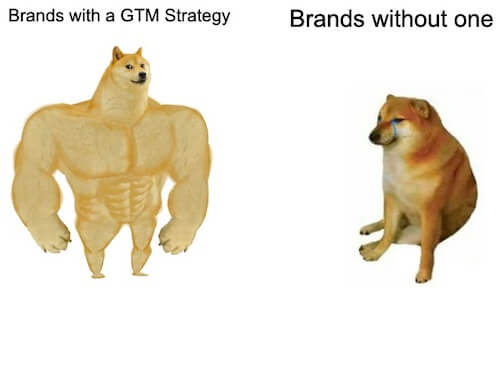What is a Go-To Marketing Strategy?
by Joseph Jones • January 30, 2024
Do you have a go-to-market strategy for your brand, product, or service? No?
Well, you’re missing out on HUGE potential with your marketing campaigns!
A go-to-market (GTM) strategy is your business game plan, bringing together essential elements like marketing, content strategy, customer insights, and brand development. Simply put, it’s a practical guide, a game plan, on how to effectively connect with your customers.
In this article, we’ll break down the essential components of an effective GTM strategy. Instead of viewing these strategies as mere instructions, let’s look at them as tools that sync your business goals with what your customers genuinely seek.
Why You Need a Go-To-Market Plan
The significance of a well-crafted GTM strategy cannot be overstated. It serves as the backbone, detailing competitive positioning, ideal customer profiles, distribution channels, promotional tactics, and sales enablement practices. Beyond merely commercializing a product, a robust GTM strategy aims to accelerate its adoption in the market.
Why does it matter? Well, it’s your shield against market anonymity and the guard against launching a product to crickets.

Step-by-Step Guide to Building a Successful GTM Strategy
Crafting a go-to-market plan/strategy involves a meticulous blend of strategies and marketing methods, aiming to give your product the best shot at success in the market.
To demystify the process and provide practical insights, this guide breaks down the essential elements you need to develop a strategy.
Let’s delve into the nuts and bolts of compiling a go-to-market strategy, making the journey from concept to market introduction more accessible and straightforward.
1. Market Research and Analysis
Market research isn’t just a buzzword; it’s the not-so-secret secret that successful businesses use to stay ahead. Here are the essentials of what you get from market research.
Validating Innovations
Before turning your idea into reality, market research acts as a reality check. Surveys, focus groups, and interviews ensure your target audience not only wants but needs what you’re planning to offer. Market research guides your development investments, minimizing risks and steering you toward the most promising opportunities.
Sizing Up Potential
Ever wondered how big your market could be? Market research has the answer. It unveils critical data on market size, growth rates, and demographic factors, revealing not only the current landscape but also adjacent segments ripe for exploration.
Benchmarking Brilliance
Keeping an eye on competitors is part of the strategy. Market research tracks competitor market share, brand awareness, pricing, and more. These benchmarks give strategic insights that position your business competitively and highlight tactical advantages in a dynamic marketplace.
Strategic Illumination
Market analysis isn’t a crystal ball to success, but it’s close. It unveils trends that shape your strategy. From market selection and product development to marketing tactics and competitive differentiation, it provides the data you need to make informed decisions and stay ahead in the game.
Maximizing Marketing Impact
Unfortunately, unlike Scrooge McDuck’s vault, marketing budgets aren’t infinite, and that’s where market research becomes your ally. It identifies high-potential customer segments, allowing you to allocate your budget where it matters most.

It also reveals media consumption habits and influencers, ensuring your message reaches the right ears through the most cost-efficient channels. The result? Better conversion rates and lower customer acquisition costs.
2. Defining a Compelling Value Proposition
Your product’s (or service’s) value proposition is essentially the benefit it delivers to consumers and the problems it solves. In simpler terms, it’s the pitch that answers why your target market should opt for your product.
As you gear up for your go-to-market strategy, it’s essential to have a clear grasp of what sets your product apart. Importantly, your value proposition should mirror not just the product but also cater to the specific needs of your target market.
For instance, while some products tout affordability, others position themselves as problem solvers for issues lacking a market solution. The unique value proposition of your product hinges on what it is and who it’s aimed at.
To define this proposition, consider the following:
- What pain points does your product alleviate?
- How does your product distinguish itself from competitors?
- What distinctive features or experiences does your product provide potential customers?
This step is all about dissecting your product’s essence, understanding its market appeal, and ensuring your go-to-market strategy aligns perfectly with what makes your product shine.
3. Messaging and Storytelling
Brand storytelling is the art of communicating a company’s values and mission in a way that captures the hearts and minds of its target audience. It creates a genuine emotional connection beyond traditional marketing messages.
Key Elements
- Emotion: A brand’s narrative should elicit a powerful emotional response from its audience. This emotional bond distinguishes brand storytelling from traditional marketing messages. By tapping into the emotions of your target audience, you can establish a deeper connection that goes beyond just being transactional.
- Relevance: Your brand story should align with the needs and desires of your target audience. It should address their pain points and aspirations, illustrating how your product or service can assist them in achieving their goals.
- Consistency: Ensure your brand story maintains consistency across all channels, spanning from your website to social media to advertising campaigns. This uniformity reinforces your message and fosters trust with your audience.
- Authenticity: Your brand story should remain authentic and true to your company’s values and mission. Customers can discern when a brand lacks genuineness, making it crucial to stay faithful to your identity.
- Visuals: Incorporate visual elements like logos, colors, and design to effectively convey your brand story memorably. These visual cues serve to reinforce your message, making it more enduring in the minds of your audience.
Unlike traditional marketing, brand storytelling focuses on creating emotional connections rather than just selling features. It taps into customer emotions, inspiring action beyond the initial transaction.
Creating customer personas can greatly assist in this part of the go-to-market strategy.
4. Choosing Distribution Channels
Sales channels refer to the avenues through which consumers make purchases of your product, while distribution channels encompass the methods by which your product reaches the end customer.
In some scenarios, sales channels align with distribution channels, especially when consumers buy directly from the manufacturer. Conversely, distribution channels can become intricate, involving a producer selling to a wholesaler, who then passes it on to a retailer, ultimately reaching the end consumer.
The choice between selling in-person or online, dealing directly with consumers or engaging wholesalers, hinges on the unique characteristics of your product. Regardless of the chosen approach, ensuring a seamless buyer’s journey is crucial to minimize friction and boost sales.
5. Promotional Tactics
Your promotion strategy is a detailed guide to introduce your product to your audience. Craft a marketing plan outlining specific steps to ensure your product reaches your target customers.
The techniques you choose depend on your product or service. One business might use a sales team, while another focuses on social media marketing for customer engagement.
Let’s address essential questions guiding your promotion strategy:
Online or Offline?
Consider where your audience is most active and tailor your approach accordingly. Are they glued to their phones? Do they read the local newspaper? (Yes, some people still read newspapers!)
Outbound or Inbound Methods?
Identify whether your audience responds better to direct methods (like phone calls) or inbound methods (like SEO and content marketing).
Where Does Your Audience Spend Time?
Invest in channels aligned with your audience’s habits, be it social media, traditional media, or other platforms.
What’s Feasible Within Your Budget?
Prioritize impactful methods that align with your budget, ensuring your strategy is both effective and cost-conscious.
Go-To-Market Strategy Example: Gymshark
A great go-to-market strategy success story is Gymshark.
Ben Francis was juggling day studies with Pizza Hut night shifts at the age of 19. Another successful entrepreneur by the name of Kylie Jenner — 18 at the time — had the perks of wealth and seasoned advisers, while Ben kicked off sewing lessons with his grandma in a family garage.
Today (January 2024), Gymshark, Ben’s brainchild, stands at a whopping $1.3 billion.
Gymshark is more than just fitness wear; it’s a tight-knit fitness community centered around a philosophy. In a saturated fitness market, Ben found his niche, targeting active fashionistas aged 18-25. “It takes zero talent to work hard and zero talent to stay humble. If you get those things right, you will always do well in your journey,” says Steve Hewitt, Gymshark’s CEO.
Bonding With Customers and Influencer Marketing
So, how did Gymshark do it? Well, their successful launch came from looking more like an influencer page than a brand page on social media. We’ll explain.
Despite the intense saturation in the fitness market, influencer marketing is increasingly prominent. According to a source from Medium.com, 49% of consumers rely on influencer recommendations, and 40% have made purchases directly influenced by Twitter (now X), YouTube, or Instagram content.
Gymshark stands out as one of the pioneers in shifting away from conventional go to marketing approaches, thanks to its strategic influencer collaborations. Ben Francis and his associates initiated this shift by targeting bodybuilders such as Lex Griffin and Chris Lavado, leveraging their influence.
Influencer marketing took center stage, with Gymshark pioneering the approach by sending free samples to fitness influencers they genuinely admired.
“Influencer marketing came totally naturally to us because we were just fans of the guys,” shares Ben in his YouTube vlog.
Gymshark’s Content Marketing Strategy
But the Gymshark success story doesn’t stop there.
Their blog adds another layer of customer connection. Articles on a healthy lifestyle, food recipes, and physical activity help drive traffic and boost brand awareness. It’s a strategy that proves even in the seemingly mundane fitness industry, compelling content can make waves.
Gymshark’s journey teaches us that a combination of different marketing strategies can help you put together a go-to-market plan that will lift — pun intended — your business to new heights.
It’s not just about what you sell — it’s about the story you tell.
To wrap it up, diving into effective marketing strategies for your go-to-market approach is a game-changer. The perks, from boosting your brand presence to amping up sales, are hard to ignore.
If you’re on the fence about adopting these tactics, now’s the time to jump in and harness their potential.
Got questions or need guidance? Reach out to Disruptive for a chat.
Let’s make your GTM strategy not just a plan but a success story.





